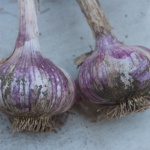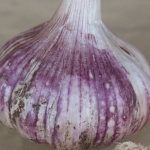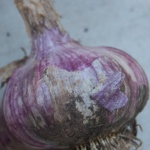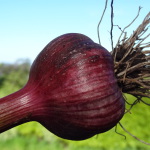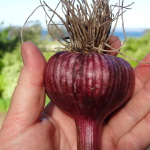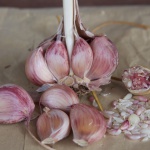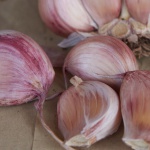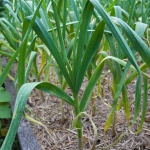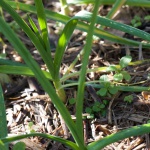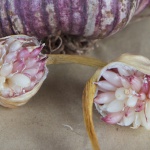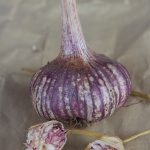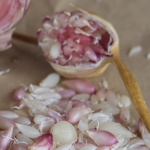Tasmanian Purple
Turban Group
Hardneck – Weakly Bolting
Tasmanian Purple probably originally came from New Zealand Purple. New Zealand Purple was called this because it came from NZ to Australia, but was never actually called this in New Zealand. New Zealand Purple was starting to be widely available in Australia in 1984 and confusingly at this time was also called Red Japanese (M. Schultz, Leeton NSW. Garlic Varieties, 1984). It is possible that many Australian Turbans have been developed from New Zealand Purple (also known as Purple New Zealand — Y strain).
General Information
| Flavour |
Rich and sweet garlic smell when cut, but generally mild with a bit of heat and pleasant taste. Quite rich and nutty when sauteed and roasted. Stronger flavoured when grown in colder regions. |
| Storage |
Short, 4-5 months. |
| Growing location |
This cultivar is not particularly fussy and grows in nearly all regions where garlic can be grown, but does particularly well in Tasmania. It is also happy in mild to warm climates. |
| Growing requirements |
Not fussy, very easy to grow. Take care not to let the plants suffer water shortage. Matures quickly once the weather heats up. |
| Planting and harvest |
Early to mid planting and harvest. |
Bulb
| Shape |
Large round and flattened, typically about 6 to 7cm.
|
| Skin colour and texture |
When freshly dug can have purple-red splotches and purple-red stripes on white. Some years the purple stripes can be very strong and the bulb can be quite purple, especially in cooler seasons. They dry mainly white with dark to pale purple stripes and became whiter toward the centre.
Skins are medium to thick wrappers and wrap the bulbs well but they are easily split and peeled and tend to split and flake away as they age.
|
Clove
| Number and layout |
In some regions and years there are 12 - 14 large cloves with typically 6 cloves in 2/3rd circle around center and another 4 cloves on the other side inside a 2nd leaf which also has 2 to 3 cloves on the inside layer. The cloves sit out from the central scape when fat. In cooler climes there may only be 8 – 10 cloves in a single layer around the centre.
|
| Size and shape |
Medium sizes cloves with average weight 5gm. The outer cloves are plump with blunt tips and of similar size and shape. The inner cloves are a bit smaller and less plump. Most have 2 flat sides with a rounded back, soft edges with the inside being somewhat rounded.
|
| Skin colour and texture |
Varies with the season and from cool to warm climates. Usually purple on tan or white with pink/purple striping, can be light tan/white with a purple/tan/rose blush around bottoms as well as purple striping and at other times mainly tan. Fine to medium thick and whilst adhering tightly to the cloves they peel easily. Range from matt to somewhat shiny.
|
Plant
| Size and shape |
Like most Turban Group garlics in mild to warm climates plants are normally strong, but not overly substantial to 45 - 50cm without the scape. In cool climates the plants are often stronger and quite substantial.
|
| Leaves |
Medium width, long and floppy many fold ½ way along the leaf. Leaves spaced up the pseudostem with medium gaps.
|
| Young plants |
Quite strong and well advanced early. Leaves well-spaced and lower leaves horizontal.
|
| Matures |
Plants mature very fast with rapid bulb development just before harvest. Must harvest as soon as the bulbs are large enough to avoid badly split skins and also side shooting. In mild to warm climates the plants weaken near maturity and in some seasons they can lean or fall over. In cooler climates the plants tend to remain strong.
|
| Scape |
Some seasons there may be 100% bolt but in other seasons some will bolt, some will send out a weak scape which does not develop and some will not send up a scape. Bolts more reliably in cooler climates.
A properly formed scape will typically be weak doing up to a 180 degree loop (upside down U) before straightening. Often the scapes do not bother with the loop instead staying straight or just hanging out there at odd angles. Scapes are normally hollow and may fall out of the bulbs as they dry after harvest. Scapes can be left to develop as they have little effect on bulb size.
|
| Umbel and beak |
The beak is long, usually 21 to 23cm. The umbel area starts out with a rose blush but becomes whitish as it develops and is short compared to others. Umbel about the size of $2 coin or bigger and a bit turban shaped.
|
| Bulbils and flowers |
Varies with the season and on the strength of the scape but typically about 25 to 50 bulbils. Various sizes 1 – 3x rice. Various shapes but typically squat and roundish widest mid-bottom, with rounded ends. Various colours dark purple/maroon, light purples, pinks and white. No flowers.
|
